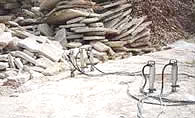Darda ROCK SPLITTERS
Sandstone - hand-driven wedges fail, splitters succeed

The Job:
At a quarry in Bloeslawiec, Poland, some 500,000 m3 of sandstone are quarried in blocks annually. The rock is stratified, has a weak crystal structure and can only be split with considerable care.
The Requirements:
No hairline cracks are permitted because the blocks are used to make facing slabs. This also means that explosives cannot be used. Formerly, the workers started the quarrying process with hand-driven wedges. This, however, was both physically demanding and particularly uneconomical, since the rock could only be poorly split in this way.
The Solution:
The solution to the problem lay in Darda hydraulic rock and concrete splitters. Before a block is produced, the workers analyse the structure of the rock, paying attention to the natural layer and cracks and precisely defining the direction of the split accordingly. With three splitting cylinders, each splitting process takes about one minute.
Following this, the split is enlarged with enlarging counter wedges, thereby overcoming the natural integrity of the sandstone block. Using this method, two men can produce blocks measuring 2 m x 1.2 m x 1.4 m in a double shift. With hydraulic splitters, block production is now 80% faster than with hand driven wedges, costs are reduced and the entire operation is considerably more economical.
